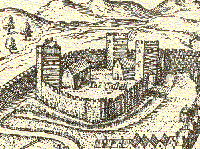| |
 |
Exeter Exeter Castle |
William the Conqueror built a castle at Exeter shortly after he had quelled the resistance of its citizens in 1068. It stands on an outcrop of reddish-coloured volcanic rock which was given the Norman French name, Rougemont. It had no motte or keep, but existed as a large enclosure in the northern angle of the Roman and Anglo-Saxon town. An outer bailey on the south side of the enclosure is known only from excavation, but the inner bailey rampart survives.
On the south-east side of the inner bailey is the well-preserved early Norman gate house. The gateway itself is now blocked. (Ground level in this area has been lowered giving the false impression that the gateway was at first floor level). The gate house has deep buttresses at front and back; those at the front are joined by an arch which allowed the second floor to be carried over the entrance. From here missiles could, no doubt, be discharged on any party attacking the gate. At first floor level, immediately above the gate, there are two unusual triangular-headed windows in Anglo-Saxon style.
By the year 1136, when King Stephen besieged Baldwin de Redvers in Exeter Castle, it had walls on the top of the southern rampart, and 'Athelstan's Tower' at the junction of this wall with the city wall may be contemporary.
Recent excavations have shown that, as part of his siege works, Stephen built a motte a little to the north of the city on a site known locally as Danes' Castle.
Bibliography
Blaylock, S. R. and Higham, R. A., 1990. 'Exeter Castle', in Royal Archaeological Institute, Proceedings of the 136th Summer Meeting, supplement to Archaeological Journal 147, 35 - 9
Cherry, B. and Pevsner, N., 1989. The Buildings of England, Devon (London, Penguin, 2nd ed.)
Hope, I., 1994 - 5. 'Exeter', Current Archaeology 141, 348